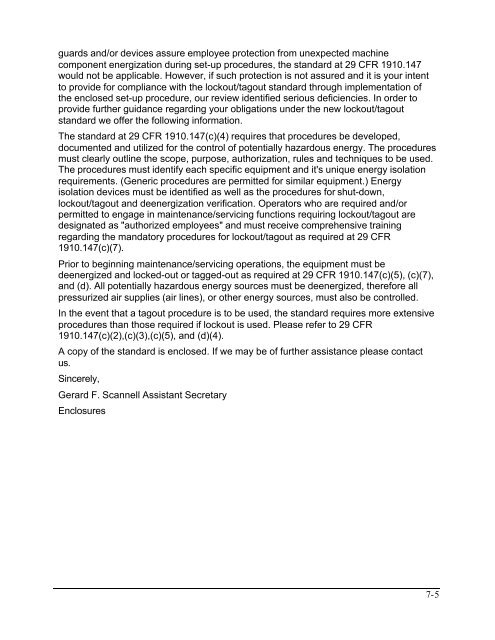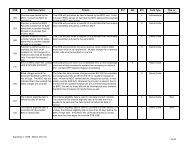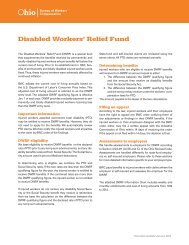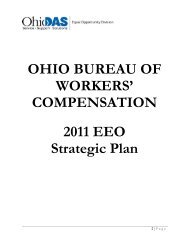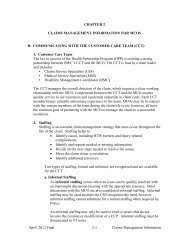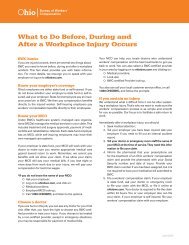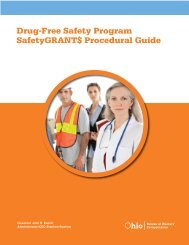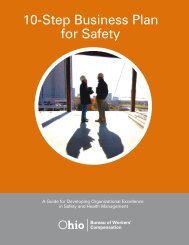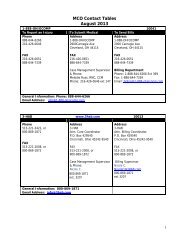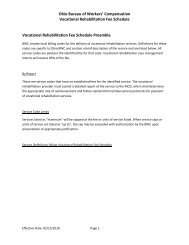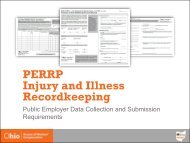Lockout / Tagout - Ohio Bureau of Workers' Compensation
Lockout / Tagout - Ohio Bureau of Workers' Compensation
Lockout / Tagout - Ohio Bureau of Workers' Compensation
You also want an ePaper? Increase the reach of your titles
YUMPU automatically turns print PDFs into web optimized ePapers that Google loves.
guards and/or devices assure employee protection from unexpected machine<br />
component energization during set-up procedures, the standard at 29 CFR 1910.147<br />
would not be applicable. However, if such protection is not assured and it is your intent<br />
to provide for compliance with the lockout/tagout standard through implementation <strong>of</strong><br />
the enclosed set-up procedure, our review identified serious deficiencies. In order to<br />
provide further guidance regarding your obligations under the new lockout/tagout<br />
standard we <strong>of</strong>fer the following information.<br />
The standard at 29 CFR 1910.147(c)(4) requires that procedures be developed,<br />
documented and utilized for the control <strong>of</strong> potentially hazardous energy. The procedures<br />
must clearly outline the scope, purpose, authorization, rules and techniques to be used.<br />
The procedures must identify each specific equipment and it's unique energy isolation<br />
requirements. (Generic procedures are permitted for similar equipment.) Energy<br />
isolation devices must be identified as well as the procedures for shut-down,<br />
lockout/tagout and deenergization verification. Operators who are required and/or<br />
permitted to engage in maintenance/servicing functions requiring lockout/tagout are<br />
designated as "authorized employees" and must receive comprehensive training<br />
regarding the mandatory procedures for lockout/tagout as required at 29 CFR<br />
1910.147(c)(7).<br />
Prior to beginning maintenance/servicing operations, the equipment must be<br />
deenergized and locked-out or tagged-out as required at 29 CFR 1910.147(c)(5), (c)(7),<br />
and (d). All potentially hazardous energy sources must be deenergized, therefore all<br />
pressurized air supplies (air lines), or other energy sources, must also be controlled.<br />
In the event that a tagout procedure is to be used, the standard requires more extensive<br />
procedures than those required if lockout is used. Please refer to 29 CFR<br />
1910.147(c)(2),(c)(3),(c)(5), and (d)(4).<br />
A copy <strong>of</strong> the standard is enclosed. If we may be <strong>of</strong> further assistance please contact<br />
us.<br />
Sincerely,<br />
Gerard F. Scannell Assistant Secretary<br />
Enclosures<br />
7-5


